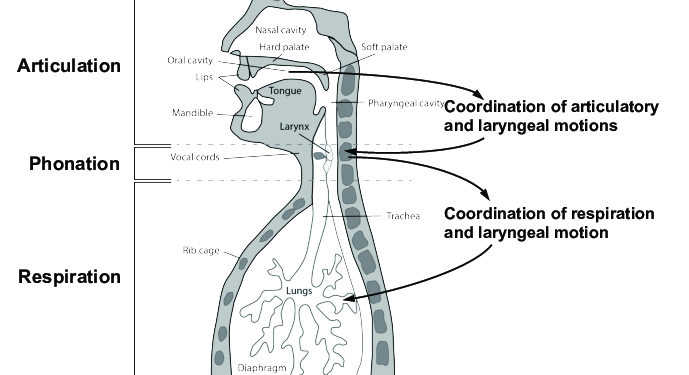Discuss with examples the main speech mechanism with reference to three systems the Respiratory System, the Phonatory System and the Articulatory System
The production of speech is a complex process that involves the coordinated functioning of several systems within the human body. The Respiratory System, Phonatory System, and Articulatory System are the three systems that comprise the main speech mechanisms. Each of these systems is essential to the creation and modification of the sounds humans make when speaking.
The Respiratory System:
The Respiratory System is the foundation of speech production. It provides the airflow necessary to generate sound by expelling air from the lungs through the vocal tract. Key components of the Respiratory System include the lungs, diaphragm, trachea, and bronchial passages. Here’s how the Respiratory System contributes to speech production:
- Diaphragmatic Breathing: During normal breathing, we engage in diaphragmatic breathing. When we inhale, the diaphragm contracts, causing the chest cavity to expand. This action creates negative pressure, drawing air into the lungs. When we exhale, the diaphragm relaxes, allowing the air to be pushed out.Example: When you take a deep breath before speaking, your diaphragm contracts and your chest expands, allowing you to store an adequate supply of air for speech.
- Controlled Exhalation: For speech, we need to control the release of air from the lungs. The muscles involved in this process are the intercostal muscles, which regulate the rate and force of exhalation.Example: When you speak, you use your intercostal muscles to control the steady flow of air out of your lungs, which is essential for generating sound.
Also Read-
The Theories on the origin of language
What are the Articulatory System
The Theories on the origin of language
The Phonatory System:
The Phonatory System involves the production of sound through the vocal cords, located within the larynx (voice box). The vocal cords vibrate as air from the Respiratory System passes through them, creating the raw material for speech sounds. Key components of the Phonatory System include the vocal cords, larynx, and associated muscles. Here’s how the Phonatory System contributes to speech production:
- Vocal Cord Vibration: When we speak, the vocal cords come together and vibrate as air passes through them. The rate of vibration determines the fundamental frequency of the voice, which contributes to pitch.Example: When you produce different pitch levels (e.g., a high-pitched or low-pitched voice), you are adjusting the tension of your vocal cords, leading to variations in their vibration rate.
- Voice Onset and Offset: The vocal cords can be set in motion or brought to rest quickly, enabling the production of plosive sounds like /p/, /t/, and /k.Example: When you say the word “stop,” you start with a quick vocal cord closure for the /st/ sound, followed by a burst of air (/t/), then another closure for the /p/ sound. These closures and releases are made possible by vocal cord control.
- Voicing Distinctions: The presence or absence of vocal cord vibration leads to distinctions between voiced and voiceless sounds. Voiced sounds are produced when the vocal cords vibrate, while voiceless sounds occur when they do not vibrate.Example: The distinction between /b/ (voiced) and /p/ (voiceless) in words like “bat” and “pat” is due to the vibration of the vocal cords in the former and their lack of vibration in the latter.
The Articulatory System:
The Articulatory System involves the manipulation of speech sounds by the tongue, lips, teeth, and other speech organs. This system shapes the raw sound generated by the Phonatory System into recognizable speech sounds. Key components of the Articulatory System include the tongue, lips, teeth, alveolar ridge, and palate. Here’s how the Articulatory System contributes to speech production:
- Place of Articulation: Different speech sounds are produced by varying the placement of the speech organs. For example, the place of articulation for the /p/ sound is the lips coming together, while the place for /t/ is the tongue against the alveolar ridge behind the upper front teeth.Example: When you say the word “pat,” you start with a /p/ sound by bringing your lips together. Then, you release the air and create a /t/ sound by placing your tongue against the alveolar ridge.
- Manner of Articulation: The manner in which airflow is obstructed or altered by the speech organs contributes to speech sound distinctions. For instance, /p/ is a voiceless bilabial stop, where airflow is completely blocked and then released.Example: When you pronounce the word “spin,” the /p/ and /s/ sounds have different manners of articulation. The /p/ is a complete stop of airflow, while the /s/ sound is a fricative, produced by partially constricting airflow.
- Vowel Formation: The position of the tongue and lips determines vowel sounds. Vowel quality is influenced by the height of the tongue (high, mid, or low), frontness or backness of the tongue, and lip rounding.Example: In the word “heat,” the /i/ sound is a high front vowel, produced with the tongue close to the roof of the mouth and the lips unrounded. In contrast, the /e/ sound in “hate” is a mid front vowel, produced with a slightly lower tongue position.
- Coarticulation: Speech sounds are not produced in isolation but rather in a continuous stream. Coarticulation refers to the influence of neighboring sounds on each other. For instance, the tongue position for a vowel may be influenced by the preceding or following consonants.Example: In the word “quick,” the /k/ sound influences the tongue position for the /i/ sound, making it slightly more fronted due to the upcoming /k/.
- Connected Speech: In fluent speech, there are often variations in pronunciation due to the influence of adjacent sounds and the need for smooth transitions between speech sounds.Example: When we say “I scream,” the /s/ sound in “scream” may be pronounced as [ʃ] (the “sh” sound) due to the influence of the following /k/ sound in “scream.”
These three speech mechanisms – the Respiratory System, the Phonatory System, and the Articulatory System – work in tandem to produce the rich variety of sounds and words in human languages. The coordination and precise control of these systems allow us to communicate effectively, conveying complex thoughts and emotions through spoken language. Understanding the interplay of these systems is fundamental to the fields of linguistics, phonetics, and speech pathology, as it helps us decipher the intricate process of speech production and how it underlies our ability to communicate with one another.
Conclusion
The three main speech mechanisms, namely the Respiratory System, the Phonatory System, and the Articulatory System, form a highly coordinated and interdependent system responsible for the production of human speech. These systems work together seamlessly to convert our thoughts and ideas into spoken language, allowing us to communicate and convey meaning effectively.
The Respiratory System provides the necessary airflow and air pressure to initiate speech. By controlling the diaphragm and intercostal muscles, individuals can regulate the flow of air from the lungs, ensuring a steady stream of air for speech production. This system also plays a critical role in the control of voice onset and offset, which is essential for creating plosive sounds and other speech features.
The Phonatory System, located within the larynx, is responsible for generating sound. Vocal cords vibrate as air from the Respiratory System passes through them, and the rate of vibration determines pitch. The presence or absence of vocal cord vibration leads to distinctions between voiced and voiceless sounds, a fundamental feature in many languages. The Phonatory System also contributes to the production of a wide range of speech sounds, enabling the articulatory system to shape them into meaningful words and sentences.
The Articulatory System involves the manipulation of speech sounds through the positioning of the tongue, lips, teeth, and other speech organs. People may produce the vast array of sounds needed for language by varying the location, style, and coarticulation of sounds. The position of the tongue and lips determines how vowels form, and connected speech has different pronunciations because surrounding sounds affect it.
These three systems are not isolated; they work in harmony to produce speech. Coarticulation ensures smooth transitions between sounds in connected speech, and individuals effortlessly adjust their speech mechanisms in real time to convey meaning accurately. The control and coordination required for speech production are a testament to the remarkable complexity of human language.
Understanding the mechanics of speech production is crucial in various fields, including linguistics, phonetics, and speech pathology. Linguists and phoneticians analyze the intricacies of how sounds are produced, while speech pathologists use this knowledge to diagnose and treat speech disorders. Furthermore, a profound comprehension of speech mechanisms is vital for language educators, helping them instruct learners in proper pronunciation and articulation.
FAQ.
1. What are the main speech mechanisms?
The main speech mechanisms are the Respiratory System, the Phonatory System, and the Articulatory System. These systems work together to produce human speech.
2. How does the Respiratory System contribute to speech production?
The Respiratory System provides the airflow necessary for speech by controlling the diaphragm and intercostal muscles, ensuring a steady flow of air from the lungs. It is the foundation for speech production.
3. What is the Phonatory System, and what is its role in speech?
The Phonatory System involves the production of sound through the vocal cords located in the larynx. It is responsible for generating the raw material for speech sounds through vocal cord vibration.
4. How do vocal cords work in speech production?
Vocal cords vibrate as air from the Respiratory System passes through them. The rate of vibration determines pitch, and the presence or absence of vocal cord vibration leads to distinctions between voiced and voiceless sounds.
5. What is the Articulatory System, and how does it contribute to speech production?
The Articulatory System involves the manipulation of speech sounds by the tongue, lips, teeth, and other speech organs. It shapes the raw sound generated by the Phonatory System into recognizable speech sounds by adjusting place and manner of articulation.
















